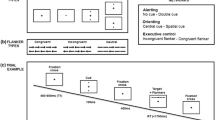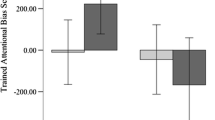Abstract
Our goal was to examine the relationship between attention and suicidal ideation in a school-based adolescent population. This cross-sectional study involved 2,462 students from eight high schools in South Korea (1,021 males and 1,441 females, mean age 17.3 ± 0.6 years). The participants completed the Beck Scale for Suicide Ideation (SSI) and the Beck Depression Inventory (BDI) and took part in computerized attention tasks. Participants with high SSI scores (16 or higher) exhibited a higher mean number of omission errors (OEs) and commission errors (CEs) on the visual sustained attention tasks than did participants with low SSI scores (p < 0.001 and p < 0.001, respectively). On the divided attention tasks, the high SSI group exhibited a higher mean number of CEs than the low SSI group did (p < 0.001). In a general linear model adjusting for age, gender, and high BDI (10 or higher), membership in the high OE group in the visual sustained attention tasks was associated with high SSI scores (p = 0.015). Belonging to the high OE or CE group in the divided attention tasks were associated with high SSI scores (p = 0.024 and p = 0.035, respectively). For both the visual sustained and divided attention tasks, interactions between gender and high OE rates were significant (p ≤ 0.001 and p = 0.013, respectively). In the post hoc analysis, membership in the high OE group was associated with high SSI scores for girls. In a multiple linear regression analysis including all participants and controlling for age, gender, and BDI scores, higher numbers of OEs and CEs on the visual sustained attention tasks predicted higher SSI scores (p < 0.001 and p = 0.019, respectively). On the divided attention task, the number of CEs was positively correlated with the SSI score (p = 0.031). The findings of this study indicate an association between attention deficits and increased suicidal ideation in adolescents after controlling for depressed mood. The current results suggest a direct link between attention deficits and increased suicidality independent of depressive symptoms in adolescents.
Similar content being viewed by others
References
OECD. OECD health data (2010) Statistics and indicators for 34 countries
Statistics Korea (2011) Causality of mortality
Keilp JG, Gorlyn M, Oquendo MA et al (2008) Attention deficit in depressed suicide attempters. Psychiatry Res 159:7–17. doi:10.1016/j.psychres.2007.08.020
Keilp JG, Gorlyn M, Russell M et al (2013) Neuropsychological function and suicidal behavior: attention control, memory and executive dysfunction in suicide attempt. Psychol Med 43:539–551. doi:10.1017/S0033291712001419
Biederman J, Monuteaux MC, Mick E et al (2006) Psychopathology in females with attention-deficit/hyperactivity disorder: a controlled, five-year prospective study. Biol Psychiatry 60:1098–1105
Cho SC, Kim JW, Choi HJ et al (2008) Associations between symptoms of attention deficit hyperactivity disorder, depression, and suicide in Korean female adolescents. Depress Anxiety 25:E142–E146
Balazs J, Miklósi M, Keresztény A et al (2014) Attention-deficit hyperactivity disorder and suicidality in a treatment naïve sample of children and adolescents. J Affect Disord 152–154:282–287. doi:10.1016/j.jad.2013.09.026
Cataldo MG, Nobile M, Lorusso ML et al (2005) Impulsivity in depressed children and adolescents: a comparison between behavioral and neuropsychological data. Psychiatry Res 136:123–133
Richard-Devantoy S, Olié E, Guillaume S et al (2013) Distinct alterations in value-based decision-making and cognitive control in suicide attempters: toward a dual neurocognitive model. J Affect Disord 151:1120–1124. doi:10.1016/j.jad.2013.06.052
Jollant F, Lawrence NL, Olié E et al (2011) The suicidal mind and brain: a review of neuropsychological and neuroimaging studies. World J Biol Psychiatry 12:319–339. doi:10.3109/15622975.2011.556200
Bridge JA, Goldstein TR, Brent DA (2006) Adolescent suicide and suicidal behavior. J Child Psychol Psychiatry 47:372–394
Borges G, Angst J, Nock MK, Ruscio AM, Kessler RC (2008) Risk factors for the incidence and persistence of suicide-related outcomes: a 10-year follow-up study using the National Comorbidity Surveys. J Affect Disord 105:25–33
Reinherz HZ, Tanner JL, Berger SR et al (2006) Adolescent suicidal ideation as predictive of psychopathology, suicidal behavior, and compromised functioning at age 30. Am J Psychiatry 163:1226–1232
Beck AT, Steer RA (1991) Manual for the Beck Scale for suicidal ideation. The Psychological Corporation, San Antonio
Lee HS, Kwon JH (2009) Validation for the Beck Scale for suicide ideation with Korean university students. Kor J Psychology 28:1155–1172
Hahn HM, Yum TH, Shin YW et al (1986) A standardization study of Beck depression inventory in Korea. J Korean neuropsychiatr Assoc 25:487–500
Yoo HK, Lee J, Kang SH et al (2009) Standardization of the comprehensive attention test for Korean children and adolescents. J Korean Acad Child Adolesc Psychiatry 20:68–75
Shin MS, Park KB, Oh KJ et al (1990) A study on suicidality in high school students. J Korean Psychol Assoc 9:1–19
Horesh N (2001) Self-report vs. computerized measures of impulsivity as a correlate of suicidal behavior. Crisis 22:27–31
Marzuk PM, Hartwell N, Leon AC et al (2005) Executive functioning in depressed patients with suicidal ideation. Acta Psychiatr Scand 112:294–301
Westheide J, Quednow BB, Kuhn KU et al (2008) Executive performance of depressed suicide attempters: the role of suicidal ideation. Eur Arch Psychiatry Clin Neurosci 258:414–421
Hawton K, Saunders KE, O’Connor RC (2012) Self-harm and suicide in adolescents. Lancet 379:2373–2382. doi:10.1016/S0140-6736(12)60322-5
Connor KR, Meldrum S, Wieczorek WF et al (2004) The association of irritability and impulsivity with suicidal ideation among 15 to 20 year old males. Suicide Life Threat Behav 34:363–374
Schaefer KE, Esposito-Smythers C, Riskind JH (2012) The role of impulsivity in the relationship between anxiety and suicidal ideation. J Affect Disord 143:95–101
Pompili M, Innamorati M, Raja M et al (2008) Suicide risk in depression and bipolar disorder: do impulsiveness-aggressiveness and pharmacotherapy predict suicidal intent? Neuropsychiatr Dis Treat 4:247–255
Cáceda R, Durand D, Cortes E et al (2014) Impulsive choice and psychological pain in acutely suicidal depressed patients. Psychosom Med 76:445–451
Ljung T, Chen Q, Lichtenstein P et al (2014) Common etiological factors of attention-deficit/hyperactivity disorder and suicidal behavior: a population-based study in Sweden. JAMA Psychiatry 71:958–964
Chronis-Tuscano A, Molina BS, Pelham WE et al (2010) Very early predictors of adolescent depression and suicide attempts in children with attention-deficit/hyperactivity disorder. Arch Gen Psychiatry 67:1044–1051
Ogundele M, Ayyash H, Banerjee S (2011) Role of computerised continuous performance task tests in ADHD. Prog Neurol Psychiatry 15:8–14
Losier BJ, McGrath PJ, Klein RM (1996) Error patterns on the continuous performance test in non-medicated and medicated samples of children with and without ADHD: a meta-analytic review. J Child Psychol Psychiatry 37:971–987
Brown RT (1982) A developmental analysis of visual and auditory sustained attention and reflection-impulsivity in hyperactive and normal children. J Learn Disabil 15:614–618
Acknowledgments
This research was supported by the Basic Science Research Program through the National Research Foundation of Korea (NRF), funded by the Ministry of Education, Science and Technology (2012R1A1A1043599).
Conflict of interest
This was not an industry-supported study. The authors have indicated no financial conflicts of interest.
Author information
Authors and Affiliations
Corresponding author
Rights and permissions
About this article
Cite this article
Kim, S.J., Kang, SG., Cho, I.H. et al. The relationship between poor performance on attention tasks and increased suicidal ideation in adolescents. Eur Child Adolesc Psychiatry 24, 1361–1368 (2015). https://doi.org/10.1007/s00787-015-0687-3
Received:
Accepted:
Published:
Issue Date:
DOI: https://doi.org/10.1007/s00787-015-0687-3




